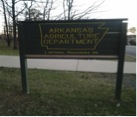Externship with the Arkansas Livestock and Poultry Commission (ALPC)
 Monday, April 8, 2013 at 09:14AM
Monday, April 8, 2013 at 09:14AM Entry, Experiences
Justin Padgett, Auburn
There is little doubt after completing a Veterinary Pathology course that the field lies at the heart of all things veterinary medicine. Whether the specific discipline be public health or internal medicine,  the skills learned and required in anatomic and microscopic pathology act as “iron sharpening iron” to enhance any DVM’s skills in a chosen trade. Pathology requires a keen knowledge of gross and microscopic anatomy, a meticulous understanding of diseases and their routes of infection, and a detailed knowledge of the body’s responses to pathogenic stimuli. It is for these reasons that I seek out any opportunity to spend extra time in the pathology laboratory and witness disease processes firsthand. I had a chance to pursue this goal this past winter break when I participated in an externship with the Arkansas Livestock and Poultry Commission (ALPC).
the skills learned and required in anatomic and microscopic pathology act as “iron sharpening iron” to enhance any DVM’s skills in a chosen trade. Pathology requires a keen knowledge of gross and microscopic anatomy, a meticulous understanding of diseases and their routes of infection, and a detailed knowledge of the body’s responses to pathogenic stimuli. It is for these reasons that I seek out any opportunity to spend extra time in the pathology laboratory and witness disease processes firsthand. I had a chance to pursue this goal this past winter break when I participated in an externship with the Arkansas Livestock and Poultry Commission (ALPC).
I was made aware of the opportunity to spend time with the ALPC through the American College of Veterinary Pathologists (ACVP) website.  The ACVP site is a great resource for any student looking to match with hosting pathology institutions that range in orientation from government to industry and research to zoo animal. The ALPC was the obvious choice for me for three reasons: its location, it was government in nature, and because of the institution’s director who would be my externship sponsor.
The ACVP site is a great resource for any student looking to match with hosting pathology institutions that range in orientation from government to industry and research to zoo animal. The ALPC was the obvious choice for me for three reasons: its location, it was government in nature, and because of the institution’s director who would be my externship sponsor.
I was attracted to the location of the ALPC because of Arkansas’ central setting. The state lies directly between the cotton and chicken states of the South and the wheat fields and feedlots of the Mid-West. Since I was looking to get a feel for a latitude and longitude of veterinary medicine, I knew this central site would allow me to see specimens that represented a wide range of the country’s animal agriculture. I was also looking to learn more about Arkansas’ agriculture industry and what specific veterinary disease problems they struggled with that may differ from that of my home state, Alabama.
The fact that the ALPC was a government agency also appealed to my goals. The lab in Little Rock is the only one in Arkansas of its kind. That means this one central diagnostic lab is key to well-being of food animals in a state that spans 53,180 square miles and has 1.8 million cows and calves, millions of meat chickens, and 280,000 swine. Granted, there are private diagnostic labs available in the state, but the ALPC is central for any and all public health threats that may endanger Arkansas animals. They will be on the front lines along with the USDA should any foreign animal vesicular disease enter the state. They are also responsible for monitoring for other dangerous diseases such as Equine Infectious Anemia. I knew my interest in veterinary public health would be piqued by this laboratory.
Dr. James Britt is the director of the ALPC and served as my externship host. His experience and reputation also attracted me to spend time in Arkansas.  Dr. Britt earned a DVM from Missouri, studied pathology at the medical college of Southern California, and has been a board certified pathologist for over 30 years. He has served as a veterinarian in both the US Air Force and Army and has been the lead pathologist for the ALPC for over 20 years. He has hosted dozens of students, is actively involved in the prominent pathology professional organization, the CL Davis Foundation, and has been “thanked” by the likes of John King (pathologist at Cornell) for his expert help with gathering and identifying necropsy images for teaching purposes. His resume was impressive and his willingness to host and teach veterinary students was certainly inviting.
Dr. Britt earned a DVM from Missouri, studied pathology at the medical college of Southern California, and has been a board certified pathologist for over 30 years. He has served as a veterinarian in both the US Air Force and Army and has been the lead pathologist for the ALPC for over 20 years. He has hosted dozens of students, is actively involved in the prominent pathology professional organization, the CL Davis Foundation, and has been “thanked” by the likes of John King (pathologist at Cornell) for his expert help with gathering and identifying necropsy images for teaching purposes. His resume was impressive and his willingness to host and teach veterinary students was certainly inviting.
My time with the ALPC was very rewarding. I spent valuable hours with Dr. Britt reviewing histopathology slides from dozens of cases. We reviewed slides from everything from a frilled lizard from the Little Rock zoo to a lymph node biopsy from a Labrador from a local small animal practice. I also spent quality time in the laboratories of the ALPC.  I cut in tissues and stained slides in histopath and toured the clinical path., serology, and toxicology labs. I was able to perform my first necropsy on a miniature schnauzer that had died from suspected strychnine poisoning. I also spent time researching diseases we ran across and refreshing my learning of studies from the previous semester in school.
I cut in tissues and stained slides in histopath and toured the clinical path., serology, and toxicology labs. I was able to perform my first necropsy on a miniature schnauzer that had died from suspected strychnine poisoning. I also spent time researching diseases we ran across and refreshing my learning of studies from the previous semester in school.
A pathology externship is rewarding for any veterinary student to participate in.  The student will spend time with agencies that are on the front lines of veterinary public health and will refresh their knowledge of many facets of the veterinary curriculum.
The student will spend time with agencies that are on the front lines of veterinary public health and will refresh their knowledge of many facets of the veterinary curriculum. It is certainly easier to remember diseases when you see them on the necropsy floor than when they are listed in a book! Students also have great funding opportunities for these experiences. I was fortunate enough to get a stipend from both the ACVP and the CL Davis Foundation for my time in Arkansas. An experience with a government diagnostic lab is also eligible for application for the AVMA Externship Stipend. I would highly encourage students to pursue an experience such as this while they are completing their veterinary education.
It is certainly easier to remember diseases when you see them on the necropsy floor than when they are listed in a book! Students also have great funding opportunities for these experiences. I was fortunate enough to get a stipend from both the ACVP and the CL Davis Foundation for my time in Arkansas. An experience with a government diagnostic lab is also eligible for application for the AVMA Externship Stipend. I would highly encourage students to pursue an experience such as this while they are completing their veterinary education.
 Auburn University,
Auburn University,  Externship,
Externship,  pathology in
pathology in  Experiences
Experiences 